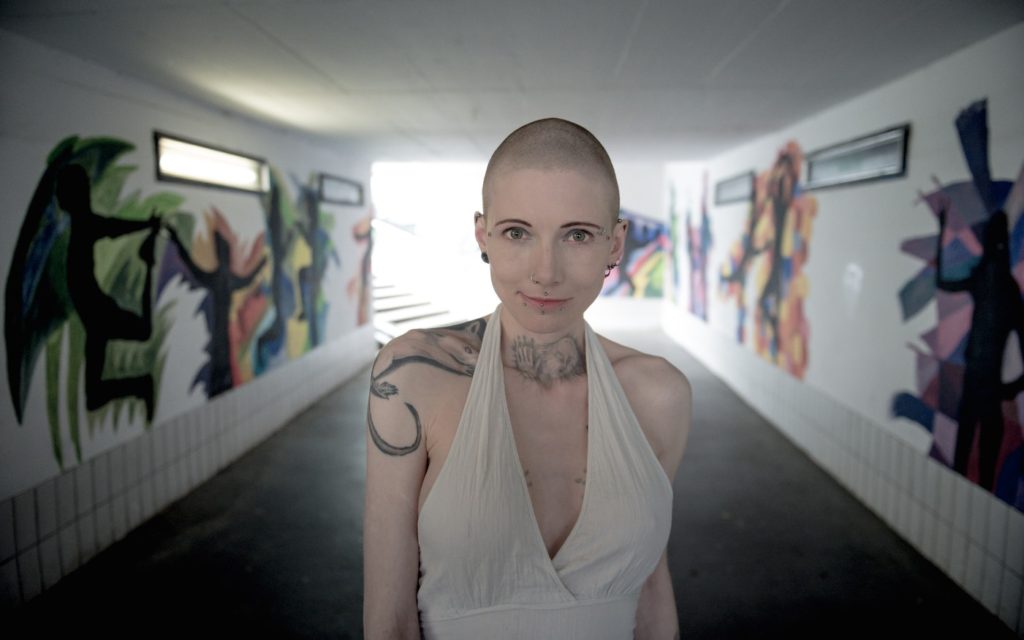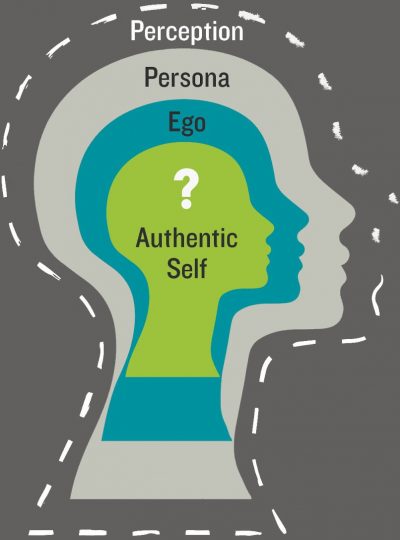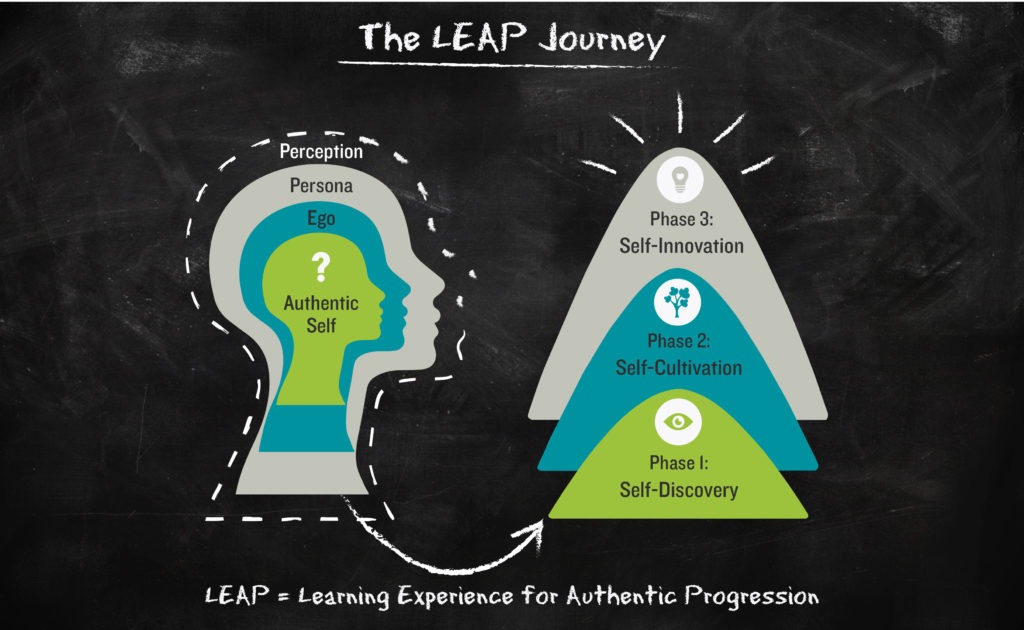
So, you’re interviewing for a new job. Or you are going on a date with someone for the first time. Naturally, you feel a bit nervous, so you ask your friend for some advice and they dispense that old adage: “You’ll be fine. Just be yourself.” I laughed in agreement with Caroline McHugh when she contemplated the ridiculousness of this little piece of advice in her TED Talk The Art of Being Yourself. People will tell you to “just be yourself” as if that is the easiest thing in the world and as if it is a completely novel idea that you haven’t considered. However, as most of us know, if it were simple to “just be ourselves”, most of us would just do it and reap the benefits.
Being ourselves often proves harder than initially anticipated for the simple reason that who we are is often more complex than we realise. As McHugh explains, and as we also teach our clients on The LEAP Journey, there are different layers to the self; making it difficult to discern which self we need to be when we are contemplating “being ourselves”. Throughout our lives, we create a Self – the Constructed Self, as depicted in the figure below – which consists of at least four different layers: (1) the Perception Self; (2) the Persona Self; (3) the Ego Self; and (4) what we at the LEAP Academy are most interested in, the Authentic or Deeper Self.

So, what is the difference between these four selves?
The Perception Self is the outermost version of the self and is how other people see you. It’s called the Perception Self for exactly this reason – it’s the perception others have of you. Our Perception Self is created by different things, and often, it is far removed from our Authentic Self. How others see us, is often not how we really are, or how we see ourselves. Or we might have become trapped in the self-imposed and never-ending cycle of having to maintain the perception – or should we say illusion – that we are fine; that our lives are going great; that we are successful, or happy, or productive, or lucky or whatever it may be. This can become quite exhausting, since no-one is ever successful, happy, productive, or lucky all the time. There is a natural eb and flow to life. Sometimes we are ahead and sometimes we are behind. Unfortunately, we live in a society that perpetuates the idea of perfectionism and that encourages us to only share the “good” parts of ourselves and our lives, and to hide the “bad” parts. The result is that our Perception Self becomes disconnected from our Authentic Self.
The Persona Self is how we would like others to see us. It is the image of ourselves that we try to project to the world, and this is the Self we use to create our Perception Self; since we cannot directly impact or change other people’s perceptions. We influence others’ perceptions of us by what we show them and what we choose not to show them. Most people have an idea of who they would like to be or who they want to become – an idealised future self – and usually the Persona Self drives this need to show only certain parts of ourselves to the world. As Caroline McHugh explains, the Persona Self is our Wish Self – i.e. who we wished we were. Of course, having a Wish Self that is completely distorted from our real or Authentic Self, can also become problematic. Not only do we then strive to build an unrealistic version of ourselves, but we are also denying our own humanity, and that which essentially makes us different or unique.
The Ego Self represents how we feel about ourselves. Our lives are a constant struggle between the extremes of self-congratulations and self-castigation. It’s a never-ending tug-of-war between the best and the worst versions of ourselves. Some days we feel great; we seem to be aligned with the natural flow of life and we feel capable and competent. Other days, nothing seems to work; we feel disconnected and frustrated, unwanted, incapable, incompetent or even worthless. The goal of the Ego Self is to find a balance somewhere in the middle. No-one is pure good or pure evil. We are human beings and human nature is flawed. Every day represents an opportunity to live our best lives and be our best selves. And there will be days that we will succeed and there will be days that we won’t have the energy to try. The trick is to try again the next day and to never give up. According to Burnett and Evans, life’s journey might seem like a finite game with a clear winner and loser, but it’s actually infinite when you consider how many opportunities you have to be your best self or live your best life. And the race is not against others; it’s against yourself.
The Authentic Self is our deepest, most real self. It’s the enduring self that you’ve always been and that will always be part of you. McHugh explains that there are two times in our lives when it is easy and natural to be our Authentic Self – when we are small children and when we are geriatric. As small children, our Ego and Persona Selves haven’t developed fully yet, and we don’t know how to be anything but our true selves. As we become domesticated, we struggle with the tug of both the Persona Self and the Ego Self. Then when we reach a certain age, we realise that we have less time ahead of us than behind us and we realise our own fragility. This realisation of our own mortality and fragility, brings with it a need to be who we are and to stop trying to please others or live up to unrealistic expectations of the self that rob us of our authentic joy. So, it could be argued that we rediscover our Authentic Self in old age. For some, this happens too late. However, if you choose to embark on The LEAP Journey, you can rediscover your Authentic Self – the Deconstructed Authentic Self – sooner and start living more authentically without having to wait until the end of your life.
So, with all this in mind and considering the benefits of living more authentically, why is it sometimes bad advice to be yourself? It’s simple really, if you don’t know your real self or Authentic Self, how do you know which self you should be? Additionally, the more we live in alignment with our Perception Self and thus in misalignment with our Authentic Self, the less self-aware we tend to be and the more our blind spots and ego defences can wreak havoc in our lives. If you are a constant chatterbox, or you have a tendency to be too critical of others, or you become anxious quite quickly and then project your concerns and fears onto others, or you are a people pleaser, but you don’t know that you do these things, then being yourself can wreak havoc in your life and relationships. You could unintentionally sabotage your career or relationship prospects by falling back on defence mechanisms and blind spots that you have no awareness about.
A lack of self-awareness thus poses a real and tangible threat to building and maintaining the life that you want. Additionally, when we lack clarity about what drives us and what we value most, we tend to let others decide for us which career options we should pursue or what we should be interested in. When we allow society or our friends or our partners to decide for us what we value, we tend to become disillusioned, frustrated and resentful quite quickly. And sometimes we can’t even explain why we feel this way. We simply feel stuck and we don’t know why. As we’ve explained in our blog post on choosing a meaningful life over a happy life, the most fundamental human need, is the need to find meaning. When we disconnect from our Authentic Self and our authentic values, we effectively disconnect from the intrinsic meaning in our lives and we tend to feel stuck or lost.
When we function from our Perception Self, we often feel that the solution to our problem of feeling stuck or lost, is to change how we present ourselves and to reinvent ourselves. So, we focus on updating our personal brand or changing our external behaviour to present a better picture of ourselves. We might even take some drastic steps like resigning from our jobs, changing careers, divorcing our partners, or starting a business. Of course, these things might work in the short-term, but before long that same feelings of being stuck and lost will return. The real solution doesn’t lie outside of us. The real solution doesn’t lie in changing the environment or attempting to change the perception that others have of us. The real solution lies within. When we dive deep to rediscover our Authentic Self and do the work to redesign and align our external life to our internal values and who we are authentically, things in our external environment shift naturally and we no longer feel stuck or lost.
It’s dangerous to “just be yourself” if you don’t know who your Authentic Self is. The LEAP Journey consists of three distinct phases and during each phase, we focus on a different layer of the Constructed Self. However, contrary to how most other transformational coaching initiatives work, we work from the inside out. During Phase 1, we temporarily ignore the Perception Self, the Persona Self, and the Ego Self, and focus all our energy on discovering and getting to know the deepest layer of the Constructed Self, i.e. the Authentic Self. The other layers of the Constructed Self are reintroduced during Phases 2 and 3 of The LEAP Journey. This process that we call Deconstructing the Constructed Self, is depicted in the figure below.

In his book, Authentic: How to be yourself and why it matters, positive psychologist Stephen Joseph, explains that there is a formula to becoming more authentic. Interestingly, Joseph’s steps in discovering your real self and becoming more authentic aligns with the process that we follow on The LEAP Journey – even though our journey and Joseph’s process were created independently.
Joseph’s first step aligns with the Delphic maxim to “Know Thyself”. According to Joseph, part of the process of coming to know yourself better, is to “look deeply within yourself, to uncover your barriers to authenticity and to begin to dismantle them.” On The LEAP Journey, the process of getting to know yourself happens during Phase 1 of the journey and is called “Self-Discovery”. Self-Discovery involves several sequential steps in peeling away the different layers of the Constructed Self and discovering your deeper Authentic Self. Discovering and getting to know your Authentic Self includes understanding your personality type, your core driving fears and motivations, coming to recognise your blind spots and ego defence mechanisms, clarifying your values, plotting and reflecting on your life and career experiences, identifying the key themes in your life, and formulating a Why or Purpose Statement that defines the essence of your Authentic Self.
The second step in Joseph’s process of becoming more authentic, is to own yourself. Joseph explains that part of the process of owning yourself, involves not seeing yourself as a victim of your circumstances, and taking responsibility for your own life. When you realise that you can shape your own life and you can determine the outcome of your life, your external environment begins to shift, and you start noticing more opportunities to build the life that you want. On The LEAP Journey, this starts with breaking with old, outdated mindsets, ideas and beliefs and moving from a scarcity mentality to an abundance mentality. The learning experiences you embark on during Phase 2 of The LEAP Journey, encourage you to create an imagined future self, to carefully craft and develop your unique strengths, and build the vitality and productivity assets you will need to move your life forward in a purposeful and empowered way. Phase 2 of The LEAP Journey is called “Self-Cultivation”, because the primary focus is on growing and expanding this newly discovered Authentic Self so that it doesn’t shrink back into the deeper levels of the self but can inform the Ego Self.
According to Joseph, the third and final step in the process of becoming more authentic is to be yourself. On The LEAP Journey, being yourself constitutes Phase 3, and is called “Self-Innovation”. Self-Innovation is a little more than simply being yourself – in the sense of your old undefined self – and is rather a process of aligning your Persona Self with your deeper Authentic Self and in a way “innovating” your old self, by incorporating actions and words that give expression to your Authentic Self. It’s a way of introducing the Authentic Self you discovered on The LEAP Journey to the world and consequently allowing your Perception Self to change as people see you giving expression to your Authentic Self more and more.
Only once there is a deep understanding of the Authentic Self and you have actively worked at cultivating this Authentic Self, does it become possible to follow the advice to “just be yourself”, because then the Self you are being, is your real Authentic Self. This self that you then choose to be, is not an idealised self or a Perception Self. It’s a realistic and level-headed version of yourself – a self that has both incredible strengths and some frustrating weaknesses. It’s the Self that only you are capable of being. When we recognise what we authentically bring to our lives that no-one else does in exactly the same way, we become the Self that life is calling us to be and to whom no comparison can be found. Living in this space sets you free to be the best possible version of yourself without feeling like you must compete with others. There is no need to make yourself less or more. You inevitably find the space that McHugh calls “Interiority” which is this unique space where we don’t suffer from a superiority complex or an inferiority complex. We simply are who we are – unapologetically authentic.
References:
- Breytenbach, C. (2018). Choosing a meaningful life over a happy life. The LEAP Journey. Available online at: https://leapjourney.org/2018/01/15/choosing-a-meaningful-life-over-a-happy-life/
- Burnett, B. & Evans, D. (2017). Designing your life: How to build a well-lived, joyful life. New York: Alfred A. Knopf.
- Joseph, S. (2017). Authentic: How to be yourself and why it matters. London: Little Brown Book Group.
- McHugh, C. (2013). The art of being yourself. TEDxMiltonKeynesWomen. Published by TEDx Talks on 15 February 2013. Available online at: https://leapjourney.org/the_leap_journey/
- (2019). Know Thyself. Available online at: https://en.wikipedia.org/wiki/Know_thyself
